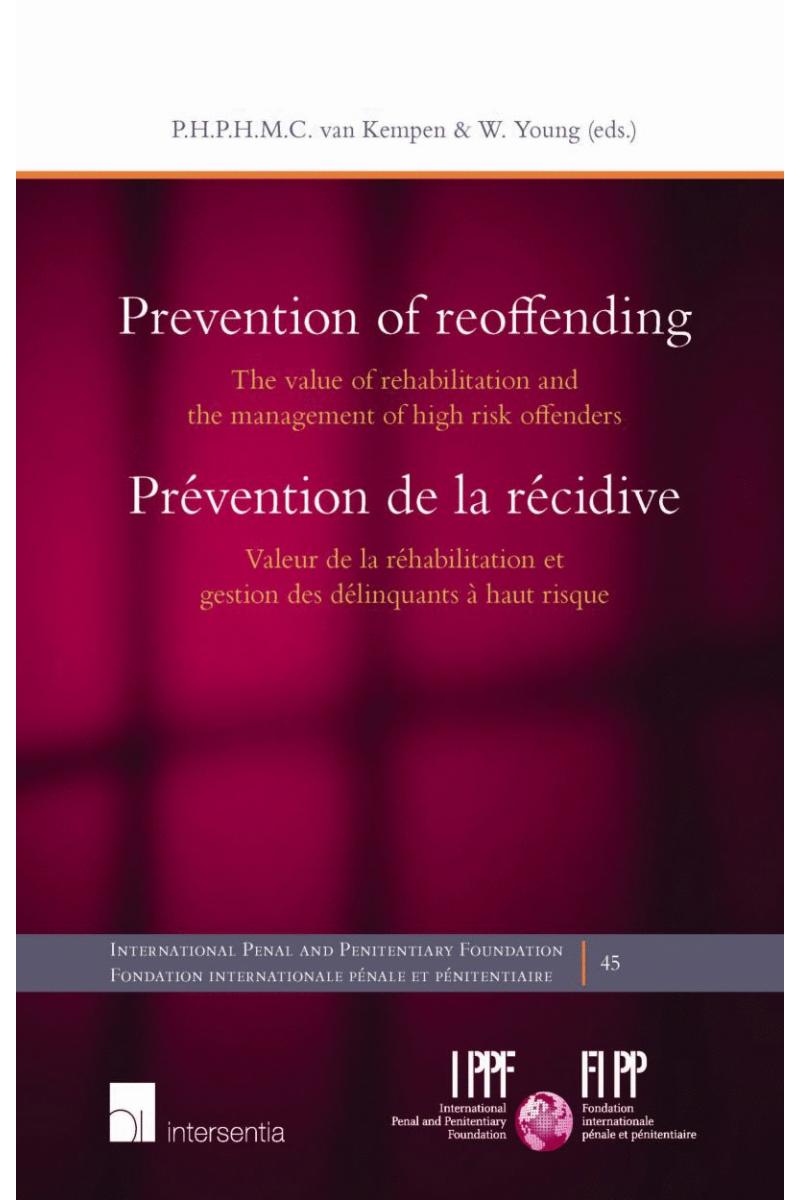 maestro
mastercard
visa
maestro
mastercard
visa

Prevention of reoffending
The value of rehabilitation and the management of high risk offenders

The need to prevent convicted prisoners and other offenders from reoffending constitutes a major challenge for both criminal justice and penitentiary systems. Reoffending rates are considerable – in many instances they are even high – while the issue is tremendously complicated. Rehabilitation (sometimes described as resocialisation, reintegration or treatment) is an important tool to prevent reoffending, but has clearly become less self-evident in many jurisdictions in recent decades. This volume therefore first of all focuses on the value of restoring offenders to a useful life from the perspective of prisoners, their family, society, the tax-payer, prison staff and administration and victims, as well as from a criminological viewpoint. Notwithstanding these actual values of rehabilitation measures, their application alone may not be sufficient to prevent someone from reoffending. This particularly applies to high risk offenders, i.e. those who pose a substantial risk of further serious offending, such as sex offenders, terrorists, and members of organized criminal groups. This volume therefore also considers measures to deal with high risk offenders during and after their sentence, and the arguments for and against their use.
La nécessité d’empêcher les détenus condamnés et autres délinquants de repasser à l’acte est le défi de taille que la justice criminelle et les systèmes pénitentiaires se doivent de relever. Les taux de récidive sont considérables (il n’est pas rare qu’ils soient même élevés) et le problème est extrêmement complexe. La réhabilitation (parfois décrite comme resocialisation, réinsertion ou encore traitement) est un outil important pour prévenir la récidive, bien qu’au cours des dernières décennies, son importance se soit clairement amoindrie dans bon nombre de juridictions. Aussi, le présent ouvrage se concentrera avant tout sur la valeur de la réintégration des délinquants dans une vie utile, tant du point de vue des détenus, de leur famille, de la société, du contribuable, du personnel et de l’administration pénitentiaires et des victimes, que d’un point de vue criminologique. Bien que la valeur des mesures de réinsertion soit bien réelle, leur seule application peut s’avérer insuffisante pour prévenir la récidive. C’est particulièrement vrai dans le cas des délinquants à haut risque, c’est-à-dire ceux qui présentent un risque important de nouveau délit grave, tels que les délinquants sexuels, les terroristes et les membres de groupes criminels organisés. Cet ouvrage abordera dès lors les mesures permettant de traiter les délinquants à haut risque durant l’exécution de leur peine et au terme de celle-ci, ainsi que les arguments favorables et défavorables à leur utilisation.
| Type of product | Book |
|---|---|
| Format | Hardback |
| EAN / ISSN | 9781780682273 |
| Series name | International Penal and Penitentiary Foundation |
| Weight | 850 g |
| Status | Available |
| Number of pages | xxii + 338 p. |
| Access to exercice | No |
| Publisher | Intersentia |
| Language | English |
| Publication Date | Jul 14, 2014 |
| Available on Strada Belgique | No |
| Available on Strada Europe | No |
| Available on Strada Luxembourg | No |
Downloads
- Table of Contents
- PART ONE. INTRODUCTORY SYNTHESIS AND ANALYSES 1ÈRE PARTIE. SYNTHÈSE ET ANALYSES INTRODUCTIVES
- Obligations and means to prevent reoffending: introduction, context and conclusions
Piet van Kempen, Warren Young - Obligations et moyens de prévention de la récidive : introduction, contexte et conclusions
Piet van Kempen, Warren Young - PART TWO. REHABILITATION OF PRISONERS 2ÈME PARTIE. LA RÉHABILITATION DES DÉTENUS
- La réhabilitation des détenus – Introduction générale
Jean Pradel - La valeur de la réhabilitation d’un point de vue criminologique
Manon Jendly, Natalia Delgrande - The value of rehabilitation to prisoners
Tim Dalton - The value of rehabilitation to the prisoner’s family
Emilia Bouzón de Terzano - The value of rehabilitation to society
Andries Charl Cilliers - The value of rehabilitation to the tax-payer
Seán Aylward - The value of rehabilitation to the prison administration
Luís de Miranda Pereira - L’importance de la réhabilitation des détenus dans l’intérêt des victimes : l’évolution de la justice restaurative
Edmundo Oliveira - PART THREE. MEASURES TO DEAL WITH HIGH RISK OFFENDERS DURING AND AFTER THEIR SENTENCE 3ÈME PARTIE. LA GESTION DES DÉLINQUANTS À RISQUE ÉLEVÉ PENDANT ET APRÈS L’EXÉCUTION DE LEUR SANCTION
- The justification for taking measures to predict offending and reoffending and to manage risk
Warren Young - The justification for taking measures to predict offending/reoffending and manage risk: a theoretical perspective – The view of a human rights lawyer
Andrew S. Butler - L’importance de la notion de risque de récidive dans la détermination du type et de la durée de la sanction
André Vallotton - The relevance of the risk of reoffending in determining the type and the length of sentences – A comparative criminal law perspective
Peter J.P. Tak - The “other” death penalty: life in prison in the United States
Emilio C. Viano - Managing the risk posed by offenders after the expiry of sentence: the British experience
Stephen Shute - Community measures to deal with high risk offenders at the periphery of the justice system
Effi Lambropoulou - La gestion des délinquants à risque élevé en France
Francis Casorla - Gestion des délinquants à risque élevé de récidive – Le cas du droit français
Jean Pradel - La gestion des délinquants à risque élevé en Italie
Franco Della Casa - Sicherungsverwahrung – A summary of recent developments regarding preventive detention in Germany
Johannes Feest - Dealing with high risk offenders – General synthesis and conclusions
Johannes Feest